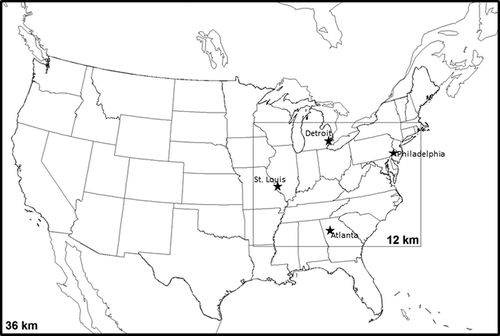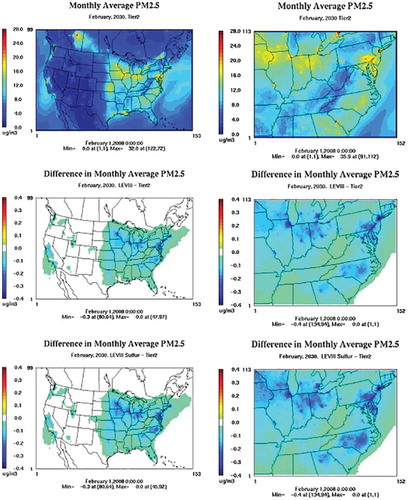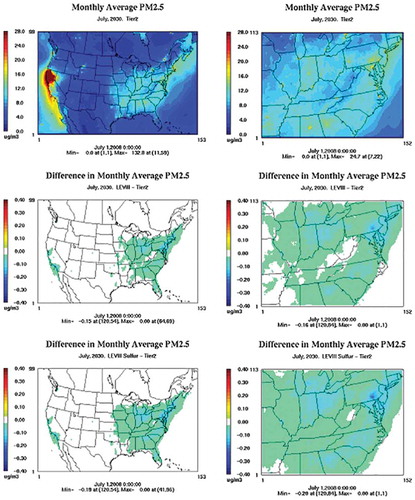ABSTRACT
Federal Tier 3 motor vehicle emission and fuel sulfur standards have been promulgated in the United States to help attain air quality standards for ozone and PM2.5 (particulate matter with an aerodynamic diameter <2.5 μm). The authors modeled a standard similar to Tier 3 (a hypothetical nationwide implementation of the California Low Emission Vehicle [LEV] III standards) and prior Tier 2 standards for on-road gasoline-fueled light-duty vehicles (gLDVs) to assess incremental air quality benefits in the United States (U.S.) and the relative contributions of gLDVs and other major source categories to ozone and PM2.5 in 2030. Strengthening Tier 2 to a Tier 3-like (LEV III) standard reduces the summertime monthly mean of daily maximum 8-hr average (MDA8) ozone in the eastern U.S. by up to 1.5 ppb (or 2%) and the maximum MDA8 ozone by up to 3.4 ppb (or 3%). Reducing gasoline sulfur content from 30 to 10 ppm is responsible for up to 0.3 ppb of the improvement in the monthly mean ozone and up to 0.8 ppb of the improvement in maximum ozone. Across four major urban areas—Atlanta, Detroit, Philadelphia, and St. Louis—gLDV contributions range from 5% to 9% and 3% to 6% of the summertime mean MDA8 ozone under Tier 2 and Tier 3, respectively, and from 7% to 11% and 3% to 7% of the maximum MDA8 ozone under Tier 2 and Tier 3, respectively. Monthly mean 24-hr PM2.5 decreases by up to 0.5 μg/m3 (or 3%) in the eastern U.S. from Tier 2 to Tier 3, with about 0.1 μg/m3 of the reduction due to the lower gasoline sulfur content. At the four urban areas under the Tier 3 program, gLDV emissions contribute 3.4–5.0% and 1.7–2.4% of the winter and summer mean 24-hr PM2.5, respectively, and 3.8–4.6% and 1.5–2.0% of the mean 24-hr PM2.5 on days with elevated PM2.5 in winter and summer, respectively.
Implications: Following U.S. Tier 3 emissions and fuel sulfur standards for gasoline-fueled passenger cars and light trucks, these vehicles are expected to contribute less than 6% of the summertime mean daily maximum 8-hr ozone and less than 7% and 4% of the winter and summer mean 24-hr PM2.5 in the eastern U.S. in 2030. On days with elevated ozone or PM2.5 at four major urban areas, these vehicles contribute less than 7% of ozone and less than 5% of PM2.5, with sources outside North America and U.S. area source emissions constituting some of the main contributors to ozone and PM2.5, respectively.
Introduction
The U.S. Environmental Protection Agency (EPA) has set new “Tier 3” vehicle emission standards for tailpipe and evaporative emissions from passenger cars, light-duty trucks, medium-duty passenger vehicles, and some heavy-duty vehicles and lowered the allowed sulfur content of gasoline to approximately 10 ppm, considering the vehicle and its fuel as an integrated system (EPA, Citation2014a). The Tier 3 standards are closely coordinated with California’s Low Emission Vehicle (LEV III) standards. The primary aim of these standards is to improve ambient air quality, as emissions of volatile organic compounds (VOCs), nitrogen oxides (NOx), and particulate matter (PM) from vehicles are often key precursors to ambient ozone (O3) and fine particulate matter (aerodynamic diameter <2.5 μm; PM2.5). The Tier 3 program is a successor to EPA’s Tier 2 federal emissions program, finalized in 2000, and the earlier Tier 1 program.
It is useful to understand the ambient air quality benefits of the Tier 3 emissions program as well as the likely major contributors to the residual ambient O3 and PM2.5 concentrations after implementation of the program. In a prior modeling study (Vijayaraghavan et al., Citation2012), we examined the incremental benefits of the Tier 1 and Tier 2 programs as well as nationwide adoption of a standard similar to the LEV III standards for on-road gasoline-fueled light-duty vehicles (gLDVs) for O3 and PM2.5 concentrations in the eastern United States (U.S.) in 2022. Gasoline sulfur was assumed to comply with a standard of 30 ppm sulfur except in California where the counties used lower sulfur, and the reductions in NOx, VOCs, and sulfur dioxide (SO2) emissions due to gasoline sulfur reductions mandated by the LEV III standard were not considered. Another limitation of the prior study was the lack of complete phase-in of the LEV III standard by 2022, the basis year for comparing emission standards. The current study builds upon the prior work by considering a more reasonable lower gasoline sulfur content and its effect on emissions, and considers a year further in the future (2030) when greater (70%) penetration of the LEV III (i.e., Tier 3) vehicle fleet is expected to occur. We also assess the relative contributions of various anthropogenic emission source categories in the U.S. and sources outside the U.S. to O3 and PM2.5 concentrations in 2030.
We apply state-of-the-science emissions models and an advanced regional three-dimensional (3-D) photochemical air quality model, the Comprehensive Air Quality Model with Extensions (CAMx) (ENVIRON, Citation2011), that simulates transport and dispersion, atmospheric chemical transformation, and deposition to the earth’s surface of trace gases and aerosols, along with the CAMx O3 Source Apportionment Technology (OSAT) (Yarwood et al., Citation1996; Dunker et al., Citation2002) and Particulate Source Apportionment Technology (PSAT) (Yarwood et al., 2005) for source apportionment. OSAT uses multiple tracer species to track the fate of ozone precursor emissions (VOC and NOx) and the ozone formation caused by these emissions within a simulation (ENVIRON, Citation2011). The tracers operate as spectators to the normal CAMx calculations so that the underlying CAMx predicted relationships between emission groups (sources) and ozone concentrations at specific locations are not perturbed. The tracers in the OSAT track the effects of chemical reaction, transport, diffusion, emissions, and deposition within CAMx and allow ozone formation from multiple “source groupings” to be tracked simultaneously, where the source grouping could be a region or source sector. Similarly, in PSAT, reactive tracers are added for each source category/region for primary PM and secondary PM and precursors. The OSAT and/or PSAT tools have been widely applied to estimate the contributions of multiple source areas and categories to O3 and PM formation in the U.S., respectively (e.g., Wagstrom et al., 2008; Koo et al., 2009; EPA, Citation2010a; Collet et al., Citation2014b). Here, we apply CAMx with these tools to estimate the incremental benefits of the different gLDV emissions and fuel programs in 2030 and to assess the contributions of gLDVs and other sources O3 and primary and secondary PM in the eastern U.S. in 2030 in hypothetical scenarios with the Tier 2 standard and nationwide LEV III standards with 30 and 10 ppm gasoline sulfur.
Methods
Modeling domain and emissions scenarios
The air quality simulations are conducted with CAMx using on-road emissions inventories derived using the Motor Vehicle Emission Simulator (MOVES) (EPA, Citation2010b) and other model inputs as discussed below. We applied version 5.40 of CAMx with the Carbon Bond 5 (CB05) chemical mechanism and version 2010a of MOVES.
The geographic region studied here follows that in Vijayaraghavan et al. (Citation2012) and includes part of the eastern U.S. with focus on 4 of 13 urban areas discussed in EPA’s PM Risk Assessment analysis (EPA, Citation2010c). The four areas selected are Atlanta, Detroit, Philadelphia, and St. Louis. The CAMx modeling domain extends over the Continental U.S. (CONUS) at 36-km horizontal resolution, with an inner nested domain at 12-km resolution over part of the eastern U.S. including the four urban areas of interest (). The domain has a pressure-based vertical structure with 26 layers, with the model top at 145 mb or approximately 14 km above mean sea level.
The model performance of this CAMx configuration was previously evaluated for a 2008 baseline year (Vijayaraghavan et al., Citation2012). The 2008 CAMx predictions of 1-hr and 8-hr average O3 concentrations were compared with measurements in the Air Quality System (AQS) network (EPA, Citation2013) and the Clean Air Status and Trends Network (CASTNET; EPA, Citation2011a). Model predictions of PM2.5 mass and components were compared with daily (24-hr) average measurements in the AQS and the Interagency Monitoring of Protected Visual Environments (IMPROVE, Citation1995) networks. Overall, model performance was good for O3 in the eastern U.S., with mean normalized bias (MNB) for 8-hr O3 ranging from 5.6% to 26.7% (depending on season and network) at over 500 monitoring stations, mean normalized error (MNE) ranging from 11.3% to 28.6%, and unpaired peak accuracy ranging from −11.9% to 28.4%, with some overprediction of summertime ozone. Model performance for 24-hr PM2.5 was found comparable to previous studies (see Vijayaraghavan et al., Citation2012, and references cited therein), with mean fractional bias (MFB) ranging from −3.4% to 49.6% at over 140 monitoring stations and mean fractional gross error (MFE) ranging from 32.8% to 54.7%. The bias and error for 24-hr PM2.5 mass and components were within the model performance criteria of Boylan and Russell (Citation2006). More detailed information on the CAMx model performance evaluation may be found elsewhere (Vijayaraghavan et al., Citation2012).
Three 2030 LDV scenarios are modeled here:
2030 Tier 2 with approximately 30 ppm gasoline sulfur (assume that only U.S. Tier 2 standards are implemented through 2030)
2030 LEV III with approximately 30 ppm gasoline sulfur (assume that the California LEV III standard is adopted nationwide, i.e., similar to Tier 3 standard, but with 30 ppm sulfur)
2030 LEV III with approximately 10 ppm gasoline sulfur (assume that the California LEV III standard is adopted nationwide, similar to Tier 3 standard with 10 ppm sulfur)
Emissions from all sources other than gLDVs are held constant across the three 2030 scenarios and calculated as described below. 2030 is chosen as the modeling year following EPA’s selection of 2030 as the future year in its Regulatory Impacts Analysis for the Tier 3 rulemaking; 70% of the vehicle miles traveled in 2030 are from vehicles that meet the fully phased-in Tier 3 standards (EPA, Citation2014b).
All simulations are conducted for a winter month (February) and summer month (July).
Meteorology
The air quality simulations with CAMx for the 2030 scenarios are driven by year 2008 meteorological fields from the Weather Research and Forecast (WRF) model–Advanced Research WRF (ARW) core (Skamarock et al., 2008). The WRF meteorological fields and performance evaluation are described elsewhere (Vijayaraghavan et al., Citation2012). The year 2008 was selected due to the availability of meteorological fields from the EPA (R. Gilliam, EPA, personal communication, 2011) and the availability of emissions from the National Emissions Inventory (NEI) used for the model performance evaluation in the prior study. The uncertainty associated with the choice of meteorological year is discussed later.
On-road motor vehicle emissions
The group of vehicle types collectively referred to as gLDVs includes three categories:
Light-duty gasoline vehicles (LDGV)
Light-duty gasoline trucks weighing less than 6000 lbs (LDGT1)
Light-duty gasoline trucks weighing between 6001 and 8500 lbs (LDGT2)
The Tier 2 program instituted gasoline sulfur and vehicle emission standards for nonmethane organic gases (NMOG), carbon monoxide (CO), NOx, and PM for model years 2004 onwards and phased in completely in 2007 for the three categories of gLDVs considered in this study. The California LEV III standards apply to vehicle model years 2015–2028, with the phase-in for O3 precursors, NOx and NMOG, completed by 2025, and that for PM by 2028. The exhaust emission standards for the Tier 2 program, the California LEV III standards and the Federal Tier 3 program for gLDVs are shown in , and . The phase-in schedule for Tier 3 PM standards is shown in Table S1.1 (Supplemental Material). The main difference between the LEV III and Tier 3 standards is that the LEV III regulates PM down to a 1 mg/mi standard, whereas Tier 3 regulates it down to 3 mg/mi only. Thus, the current study, which applies the LEV III standard on a nationwide basis, simulates greater PM reduction than the Federal Tier 3 standard.
Table 1. Light-duty gasoline-vehicle exhaust emission standardsa,b (g/mi at 10 years/100,000 milesc).
Table 2. Tier 3 LDV, LDT, and MDPV fleet average FTP NMOG + NOx standards (mg/mi) (source: EPA, Citation2014a).
Table 3. Tier 3 LDV, LDT, and MDPV fleet average SFTP NMOG + NOx standards (mg/mi) (source: EPA, Citation2014a).
MOVES 2010a is used to prepare on-road emissions inventories in the CONUS for the three 2030 emissions scenarios. MOVES is run for calendar year 2030 for vehicle aged 0–30 to develop on-road vehicle emissions for each scenario.
The emission factors complying with the LEV III or Tier 3 standards do not exist by default in MOVES and are simulated using alternative emissions inventory tools. Ratios of LEV III to LEV II emissions from the California Air Resources Board’s LEV III Inventory Database Tool (California Air Resources Board, Citation2011) are used to adjust MOVES model LEV II emission factors (EPA, Citation2010d) to calculate emission factors for the 2030 scenario of LEV III standards with approximately 30 ppm sulfur.
The 2010a version of MOVES includes the effect of low-sulfur gasoline (below 30 ppm) on exhaust emissions, but adjusts emissions via extrapolation from 30 ppm gasoline sulfur data collected from vehicles less modern than Tier 2. For this study, we improve upon the MOVES method by modeling the gasoline fuel sulfur effect using the California Predictive Model (California Air Resources Board, Citation2012). Exhaust emissions ratios from gasoline LDVs operating on ~10 ppm sulfur gasoline over ~30 ppm sulfur gasoline are used to adjust the emissions from the LEV III with ~30 ppm sulfur gasoline scenario to generate the LEV III with ~10 ppm sulfur gasoline scenario. The low-sulfur gasoline effects on emissions are estimated not only for gLDVs but all gasoline-fueled vehicle classes, including motorcycles and heavy-duty gasoline vehicles. Detailed information on the calculation of the on-road emissions in the three 2030 scenarios is provided in Supplemental Material (Section S2). A comparison of the on-road emissions results from the current study with those of the EPA Tier 3 rulemaking analysis for 2030 is also presented in Supplemental Material (Section S3).
CAMx-ready emissions are prepared from MOVES outputs following methods described earlier (Vijayaraghavan et al., Citation2012). The on-road emissions for winter and summer from MOVES for the three emissions scenarios are speciated to CAMx model species, spatially allocated to grid cells, and temporally allocated to hourly emissions using version 2.7 of the Sparse Matrix Operator Kernel Emissions (SMOKE) model (http://cmascenter.org/smoke). Emission estimates for total VOC are converted to the CB05 chemical mechanism in CAMx using VOC speciation profiles derived from EPA’s SPECIATE database, version 4.3 (EPA, Citation2011b). PM emissions are speciated to primary organic aerosol, primary elemental carbon, primary nitrate, primary sulfate, primary fine other PM, and coarse PM following methods outlined by Baek and DenBleyker (Citation2010). On-road mobile sources generated using MOVES at the county level are allocated to CAMx 36-km and 12-km grid cells using spatial surrogates derived with the Spatial Surrogate Tool (http://www.epa.gov/ttn/chief/emch/spatial/spatialsurrogate.html).
Other emissions
Emissions from anthropogenic area and point sources in the CONUS other than on-road emissions for the 2030 emissions scenarios are compiled from the EPA 2030 inventory developed for the modeling analysis of the Heavy Duty Vehicle Green House Gas (HDGHG) Rule with emissions projected by EPA from 2005 data (EPA, Citation2011c). The source sectors obtained from the 2030 HDGHG inventory include fugitive dust, agricultural, nonpoint, electric generating units (EGUs), point sources other than EGUs, aircraft, locomotives, commercial marine vehicles, and nonroad sources. We used the projections by EPA for 2020 for anthropogenic area and point emissions for Canada and Mexico (EPA, Citation2010e) because these sources are not projected to 2030 in the EPA 2030 HDGHG modeling platform. The model simulations applied biogenic emissions of CO, nitric oxide, isoprene, and other VOCs, wildfire emissions of CO, NOx, VOCs, sulfur dioxide (SO2), ammonia (NH3), and PM and sea salt emissions of particulate sodium, chloride, and sulfate developed previously (Vijayaraghavan et al., Citation2012) across the CAMx 36-km domain and are held constant across the emissions scenarios. All emissions inventories described above are converted to speciated, gridded, temporally varying emissions files suitable for air quality modeling with CAMx in the nested 36/12-km domains and are held constant across the three 2030 scenarios.
Other model inputs
Boundary concentrations of O3, PM components and precursors, landuse/landcover data, and photolysis rates were obtained from the prior study (Vijayaraghavan et al., Citation2012) and held constant across the 2030 scenarios. In particular, boundary concentrations of O3 and PM components and precursors for February and July 2008 (in addition to a 15-day model spin-up in each case) for the CAMx 36-km domain were derived from the global chemical and transport model, Model for Ozone and Related Chemical Tracers (MOZART) version 4.6 (Emmons et al., Citation2010), which applied 2008 meteorology driven by the Goddard Earth Observing System Model version 5 (GEOS-5; http://gmao.gsfc.nasa.gov/GEOS/) and global emissions inventory compiled during the Arctic Research of the Composition of the Troposphere from Aircraft and Satellites (ARCTAS) project (http://bio.cgrer.uiowa.edu/arctas/emission.html). Six-hourly model outputs in a latitude-longitude coordinate system with a spatial resolution of about 2.8° for both latitude and longitude and 28 vertical layers were mapped onto the CAMx domain and speciated for the CB05 chemical mechanism.
Emission sources and other categories for source attribution
Tracers are added in the OSAT tool in CAMx to track O3 formation from O3 precursors from the source categories shown in . These include anthropogenic and natural sources in the U.S., sources in Canada and Mexico, as well as the contribution of sources outside North America through boundary conditions for the 36-km grid resolution domain, referred to here as the North American background. The PSAT algorithm is similarly applied to track PM and precursors from these source categories.
Table 4. Source categories for source attribution.
Results and discussion
Emissions
In general, the gLDV emissions of VOC, NOx, PM2.5, CO, and SO2 respond similarly in the four urban areas to the shift from Tier 2 to adoption of the LEV III standards and lower sulfur gasoline ( and ). However, the emission benefits are most pronounced in Detroit. The emission reductions from adopting LEV III emission standards with 10 ppm sulfur gasoline (i.e., percent change from Tier 2 to LEV III with 10 ppm S) are larger on a relative basis in Detroit than the other cities and the national total because Detroit’s gasoline LDV fleet is modeled using a younger fleet age distribution, resulting in LEV III vehicles making up a larger portion of the LDV fleet (i.e., it has more LDVs of the newer model years, including those that are affected by LEV III [2015+] than the fleets from other cities). When considering emissions from all on-road vehicles for an average winter and summer day ( and ), the NOx benefit in Detroit due to the Tier 3-like standards is not distinctly larger than in the other areas because NOx emissions from heavy-duty vehicles are not reduced in the LEV III scenario in any of the urban areas.
Table 5. Emissions from gasoline-fueled LDVs, winter 2030.
Table 6. Emissions from gasoline-fueled LDVs, summer 2030.
Table 7. Emissions from all on-road vehicles, winter 2030.
Table 8. Emissions from all on-road vehicles, summer 2030.
If emission standards and gasoline sulfur regulations were to remain at the Tier 2 level with 30 ppm sulfur, the average 2030 VOC emissions from gLDVs during winter are approximately 1,900 Mg per day and slightly higher in summer. The adoption of more stringent LEV III emission controls with 30 ppm sulfur gasoline reduces the total on-road VOC emissions in the CONUS by 28% in both summer and winter relative to the Tier 2 case. The additional VOC benefit of switching to ~10 ppm sulfur gasoline (i.e., a standard similar to Tier 3) is 1%. The total CONUS NOx emissions from gLDVs in Tier 2 with ~30 ppm sulfur gasoline are approximately 2,000 Mg per day on an average winter day and slightly higher in summer. The nationwide adoption of LEV III with ~30 ppm sulfur gasoline is estimated to reduce CONUS total on-road NOx by 15%, and the reduction in gasoline sulfur to a 10 ppm standard reduces NOx by another 4%. The total NOx reduction is 19%, comparing the most stringent scenario (LEV III with 10 ppm sulfur standard gasoline) with the Tier 2 scenario.
NOx emissions are higher in summer because higher running exhaust in summer more than compensate for higher cold start emissions in winter; more vehicle miles traveled (VMT) in summer results in more fuel consumed and higher NOx exhaust emissions. In particular, Atlanta has the highest LDV emissions of NOx, VOC, and PM2.5 among the urban areas in summer due to a combination of higher ambient temperatures and higher VMT. SO2 is higher in summer in all urban areas due to higher VMT. CO is higher in winter due to more frequent cold starts resulting from lower temperatures. Also, the higher average temperatures in summer result in more air-conditioning in vehicles, and that is accounted for in MOVES. The use of air-conditioning systems increases VOCs, CO, and NOx emissions, but cold starts affect primarily CO (and VOCs to a lesser extent).
PM2.5 emissions from gLDVs in the Tier 2 scenario are 74% higher for the average winter day compared with summer due to cold temperature effects on gasoline-vehicle PM exhaust. The gLDVs accounted for 78% and 66% of the total on-road PM2.5 emissions during winter and summer, respectively. However, the on-road PM2.5 emissions represent a very small fraction of total anthropogenic PM2.5 inventory (see below). Compared with the Tier 2 scenario, the LEV III with ~10 ppm sulfur case reduces the gasoline LDV PM2.5 emissions by 35% in winter and 24% in summer, and the CONUS total on-road PM2.5 emissions by 27% and 16% in winter and summer, respectively.
presents the total anthropogenic emissions estimated in the CONUS and the fractions of the major source categories in February and July 2030 with a nationwide LEV III standard with 10 ppm gasoline sulfur. Similar plots are shown in Supplemental Material for the Tier 2 program and with a nationwide LEV III standard with 30 ppm sulfur (Figures S4.1 and S4.2). The sectors shown include area sources (comprising residential, commercial, and small industrial sources), EGUs, stationary point sources other than EGUs (abbreviated here as non-EGU Pt), off-road sources, gLDVs and other on-road sources. Following the implementation of the LEV III standard, NOx emissions from gLDVs in 2030 represent 6% of the total CONUS anthropogenic inventory, reduced from 20% in 2008 (Vijayaraghavan et al., Citation2012) and 9% in 2030 with the Tier 2 standard (Supplemental Material). NOx emissions from all on-road vehicles constitute approximately 18% of the total with the LEV III standard. Emissions from EGUs and point sources other than EGUs constitute the two largest NOx source categories in the U.S. in 2030, each representing approximately 22% of the 2030 inventory.
Figure 2. Estimated wintertime and summertime anthropogenic emissions in the continental U.S. in 2030 with a nationwide LEV III standard with 10 ppm gasoline sulfur (Tier 3-like standard).

The on-road fraction of the anthropogenic inventory varies considerably across pollutants; it is highest for CO (28–49%), lower for VOCs (7%), and negligible for SO2 (0.2%). CO emissions are dominated by on-road vehicles in winter but by off-road sources in summer (48% of total CO inventory). The doubling of off-road CO emissions from winter to summer is due to the sharp increase in usage in summer of the major nonroad emission sources: lawn and garden equipment and commercial equipment. Due to their slow reactivity, CO emissions have a much smaller effect on O3 concentrations than NOx or VOC emissions. NH3 emissions from gLDVs constitute a large fraction (85%) of total on-road emissions but represent a very small fraction (2%) of the total anthropogenic inventory due to the dominance of other sources such as livestock farming. Although primary PM2.5 emissions from vehicles can directly affect ambient PM2.5, these represent a very small fraction (2–3%) of the total anthropogenic inventory; there is a much larger PM contribution from stationary sources, road dust, wood-burning, and other sources.
Ambient air quality
If LDV emission standards in 2030 were no more stringent than the Tier 2 standard, the summertime monthly mean of the MDA8 O3 could be as high as 76 ppb over the eastern U.S. (near Washington, DC), with values exceeding 60 ppb in large parts of the eastern U.S. and the New York/New Jersey/Washington, DC, corridor experiencing more than 70 ppb (). When considering the entire CONUS, the monthly mean goes up to 88 ppb, with the highest value predicted in the Los Angeles basin. The incremental benefits of the nationwide LEV III standards are examined by difference with the Tier 2 scenario (; here “LEVIII” denotes the 30 ppm scenario and “LEVIIISulfur” denotes the 10 ppm scenario). Strengthening the Tier 2 standard to the Tier 3-like standard (LEV III with 10 ppm sulfur limit) results in a reduction of approximately 1 ppb in the monthly mean of MDA8 ozone in large parts of the eastern U.S. and up to 1.5 ppb (a 2.1% reduction from a maximum concentration of 70 ppb) near New York City. Reducing the gasoline sulfur limit from approximately 30 to 10 ppm reduces the monthly mean of MDA8 O3 by up to 0.3 ppb in parts of the eastern U.S. (Figure S5.1). The monthly maximum of MDA8 O3 with the Tier 3-like standard () exceeds 75 ppb in large parts of the eastern U.S., including Connecticut, Maryland, Pennsylvania, New Jersey, and New York City). Concentrations exceeding 75 ppb were also modeled by Collet et al. (Citation2014a) in comparable regions in the eastern U.S. in a 2030 modeling study with a different air quality model, the Community Multiscale Air Quality Model (CMAQ). We find that the maximum reduction in the monthly maximum of MDA8 O3 in the eastern U.S. is 2.8 ppb (or 2.7% from a concentration of 105 ppb near Washington, DC) from Tier 2 to the LEV III scenario with 30 ppm sulfur and by up to an additional 0.6 ppb (a 3.3% overall reduction from Tier 2) with the lower 10 ppm limit.
Figure 3. Monthly mean of daily maximum 8-hr ozone concentrations in July 2030 in the 36-km domain (left) and 12-km domain (right) in the Tier 2 scenario (top), “LEV III with 30 ppm sulfur” − Tier 2 (middle), and “LEV III with 10 ppm sulfur” − Tier 2 (bottom).
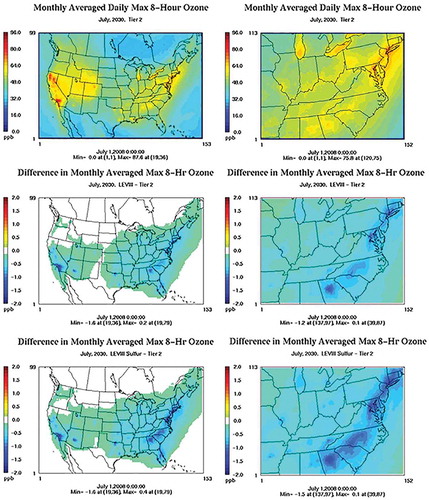
Figure 4. Monthly maximum of daily maximum 8-hr ozone concentrations in July 2030 in the 36-km domain (left) and 12-km domain (right) in the Tier 2 scenario (top), LEV III with 10 ppm sulfur scenario (middle), and “LEV III with 10 ppm sulfur” − Tier 2 (bottom).
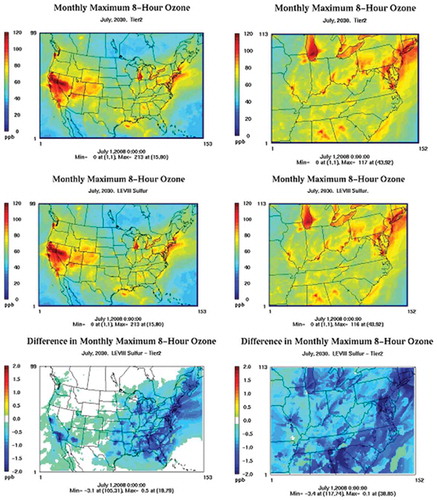
Wintertime monthly mean concentrations of PM2.5 mass in the 2030 Tier 2 scenario exceed 15 μg/m3 (the annual mean standard for PM2.5) in large parts of the Upper Midwest, Georgia, North Carolina, and the Northeast (). The monthly mean decreases by up to 0.4 μg/m3 (a 2.7% reduction) in the LEV III 30 ppm scenario and by less than 0.1 μg/m3 additionally (a 3.3% overall reduction from Tier 2) with the lower 10 ppm standard (Figure S5.2). Reductions in PM2.5 concentrations between the Tier 2 and LEV III scenarios are generally lower in summer () than winter, a maximum improvement of 0.2 μg/m3 in winter versus 0.4 μg/m3 in winter. This is likely due, in part, to less formation of PM nitrate from NOx emissions in summer due to enhanced volatilization from the particulate phase (Vijayaraghavan et al., Citation2012). The exceptionally high summertime PM2.5 concentrations predicted in northern California (>100 μg/m3) are due to emissions from extreme wildfire events in this region. Improvements in PM2.5 are negligible in switching from 30 to 10 ppm sulfur except for some small reductions (0.04 μg/m3) in the Northeast (Figure S5.3).
Ozone and PM2.5 source apportionment
The OSAT tool in CAMx is used to track the ozone contribution from different emission groups with emphasis on the gLDVs. The summertime gLDV contributions to the monthly averaged MDA8 O3 in 2030 under the Tier 2 program are highest in New York City, Atlanta, and Washington, DC, each averaging approximately 6 ppb O3 (), or approximately 9.4% (Figure S5.4). The LEV III program with 30 ppm sulfur results in reductions in gLDV contributions of approximately 1.8 ppb in the regions with the highest contributions in Tier 2. Additional reductions in the gLDV contribution with a 10 ppm sulfur limit are much smaller, less than 0.4 ppb throughout the domain. Overall, gLDVs in the LEV III scenario with 10 ppm sulfur contribute less than 5.5% to the monthly averaged MDA8 O3 in most of the eastern U.S. (Figure S5.4), with the peak contribution of 6.1% near Atlanta. Ozone attainment will likely be influenced more by emission source contributions on days with elevated ozone concentrations. When considering the monthly highest MDA8 O3, gLDV contributions range from 0 to 5 ppb across most of the eastern U.S. (), with a peak absolute contribution of 7.9 ppb near Washington, DC, and a peak relative contribution of 10% (not shown) near Raleigh in North Carolina.
Figure 7. Contribution of gLDVs to the monthly mean of daily maximum 8-hr ozone in July 2030 in three scenarios: Tier 2 (top left), LEV III with 30 ppm sulfur (top middle), LEV III with 10 ppm sulfur (top right), “LEV III with 30 ppm sulfur” − Tier 2 (bottom middle), “LEV III with 10 ppm sulfur” − “LEV III with 30 ppm sulfur” (bottom right).
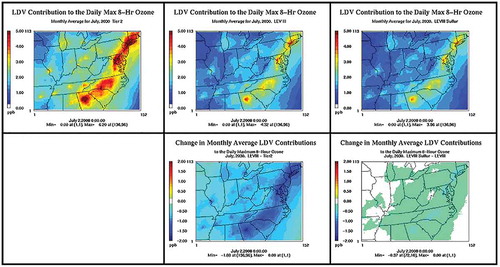
Figure 8. Monthly maximum of daily maximum 8-hr ozone concentrations in July 2030 in the LEV III 10 ppm sulfur scenario (left) and contribution of gLDVs to the maximum ozone concentration (right).
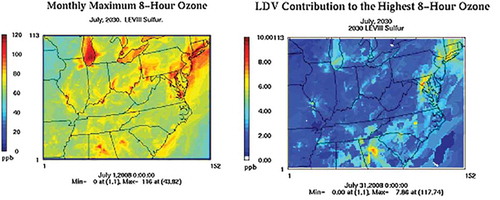
presents the relative contributions from the eight emission categories (listed in ) and the North American background (boundary conditions) to the summertime monthly mean of MDA8 O3 in Atlanta and Detroit in 2030. Similar plots are shown in Figure S5.5 for Philadelphia and St. Louis. Under the Tier 2 scenario, gLDVs are predicted to contribute 5 to 6% of the summertime mean MDA8 O3 in Detroit, Philadelphia, and St. Louis, with the contribution higher in Atlanta at 9%. Under the Tier 3-like standard (the LEV III scenario with 10 ppm sulfur), the on-road LDV contributions to summertime mean MDA8 O3 are reduced to 3–6%, whereas the North American background contributes 28–39% to the summertime mean O3 across these four urban areas (or approximately 19–20 ppb in each area). The contribution of gLDVs to the monthly highest MDA8 O3 ( and S5.6) ranges from 6% to 11% under Tier 2 at the four urban areas. The Tier 3 emissions and fuel sulfur standards are effective in reducing the gLDV contribution to 3–7% of the highest MDA8 O3 across these four areas. Interestingly, the share of the North American background to O3 at Detroit drops from 39% to 19% when considering the day with highest ozone in July rather than the monthly mean, with that share picked up now by non-EGU point sources, EGUs, and natural sources.
Figure 9. Source apportionment of monthly mean of daily maximum 8-hr ozone in July 2030 in Tier 2 (left) and LEV III 10 ppm sulfur scenario (right) in Atlanta (top) and Detroit (bottom).
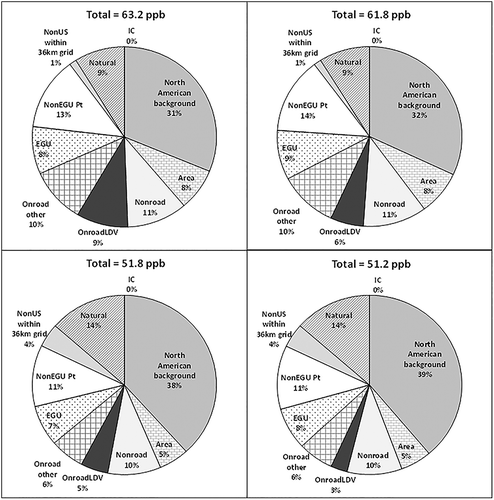
Figure 10. Source apportionment of monthly maximum of daily maximum 8-hr ozone in July 2030 in Tier 2 (left) and LEV III 10 ppm sulfur scenario (right) in Atlanta (top) and Detroit (bottom).
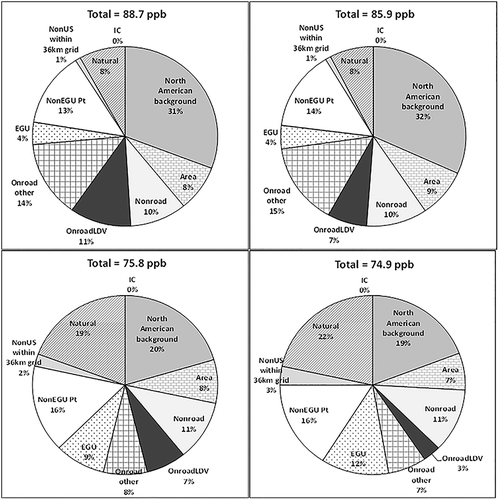
The gLDV contribution to monthly mean PM2.5 is higher in February than in July ( and S5.7) in all three scenarios due, in part, to higher gLDV primary PM2.5 emissions arising from colder temperatures in winter. Under the Tier 2 scenario, the wintertime gLDV contributions are highest in urban areas in the upper Midwest and between Washington, DC, and New York City, with a peak contribution of 1.7 μg/m3 (or 9% of the total PM2.5). LDV contributions in the southeastern U.S. are generally smaller than in the Northeast. The wintertime gLDV contribution is lower by between 0.3 and 0.4 μg/m3 in the LEV III 30 ppm scenario compared with the Tier 2 scenario in New York City, Chicago, and Detroit, representing 2% reductions in each region. Further strengthening of the standard to 10 ppm sulfur offered little additional PM2.5 reductions in the 12-km domain. The largest PM2.5 benefit going from Tier 2 to the LEV III with 30 ppm sulfur scenario (0.4 μg/m3) is an order of magnitude greater than the largest benefit (0.04 μg/m3) when transitioning from LEV III with 30 ppm sulfur to 10 ppm sulfur. This follows the smaller reduction in PM2.5 precursor emissions with the transition from 30 to 10 ppm sulfur compared with the transition from Tier 2 to LEV III with 30 ppm sulfur. In July, gLDVs account for up to 4.3% of the total PM2.5 under the Tier 2 program; the highest contribution is 0.6 μg/m3 in New York City. The LEV III program with 30 ppm sulfur reduces the PM2.5 contribution up to 0.12 μg/m3; lowering the gasoline sulfur content to 10 ppm decreases the mean July contribution by less than 0.02 μg/m3.
Figure 11. Contribution of gLDVs to monthly average PM2.5 in February 2030. Absolute contribution in μg/m3 (top) and relative contribution in % (bottom): Tier 2 (left), LEV III with 30 ppm sulfur (middle), and LEV III with 10 ppm sulfur (right).
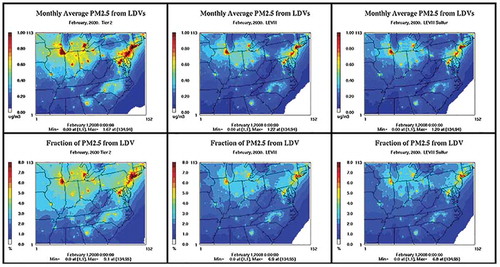
and S5.8 present relative source contributions to the wintertime monthly mean of 24-hr PM2.5 in Atlanta, Detroit, Philadelphia, and St. Louis in 2030. Similar plots are shown for summertime in and S5.9. Area source emissions (i.e., nonpoint sources) are the largest contributor to monthly averaged PM2.5 in both winter and summer in all four urban areas in both scenarios, constituting 29–45% of the total PM2.5, followed by non-EGU point sources in Detroit, Philadelphia, and St. Louis. Natural sources contribute over a third to mean summertime PM2.5 in Atlanta, likely reflecting the influence of biogenic emissions in the region. On-road gLDVs account for 5–7% of the total PM2.5 in February under Tier 2 controls, with the highest relative contribution in Detroit. As explained above, Detroit experiences a larger percent reduction in emissions from Tier 2 to LEV III compared with other three urban areas. LEV III controls with 30 ppm sulfur reduced the LDV impact by 2% in Detroit and 1% elsewhere from Tier 2 controls. Lowering the gasoline sulfur to 10 ppm offered little additional improvement for PM2.5. In July, area, other, and non-EGU point sources are the largest contributors to PM2.5 at these four cities. LDV contributions amounted to 2–3% of the total PM2.5 under Tier 2 controls, and 2% under the LEV III scenarios at all four sites.
Figure 12. Source apportionment of monthly average 24-hr PM2.5 in February 2030 in Tier 2 (left) and LEV III 10 ppm sulfur scenario (right) in Atlanta (top) and Detroit (bottom).
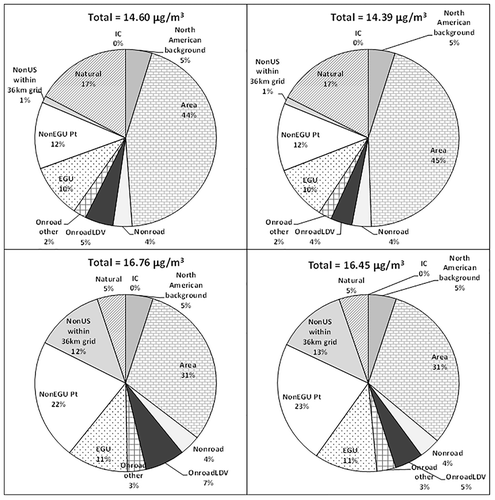
Figure 13. Source apportionment of monthly average 24-hr PM2.5 in July 2030 in Tier 2 (left) and LEV III 10 ppm sulfur scenario (right) in Atlanta (top) and Detroit (bottom).
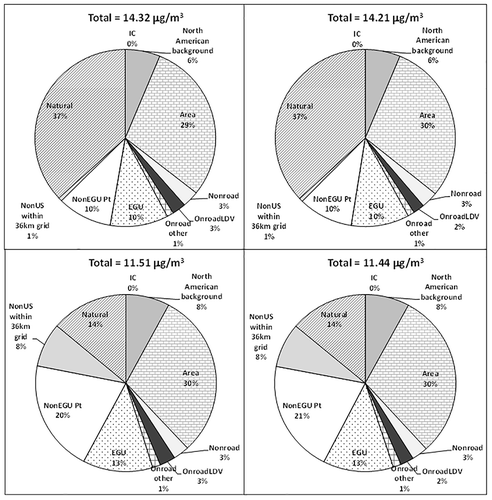
To investigate whether gLDVs have a larger contribution to days with elevated PM2.5 than the monthly mean PM2.5, we identified days with higher PM2.5 (defined here as those with 24-hr PM2.5 exceeding 15 μg/m3) and calculated average contributions from each source sector across those days. The threshold of 15 μg/m3 is somewhat arbitrary and is chosen to account roughly for the top 20–30% of days in each month for 24-hr PM2.5. The results of this source apportionment at the four urban areas are presented in , , S5.10, and S5.11. When considering days with elevated PM2.5 only, the relative contribution of gLDVs to 24-hr PM2.5 in winter and summer in the four urban areas ranges from 2% to 7% under Tier 2 and reducing to 1–5% under the Tier 3-like standard, and in both cases about 0.2% higher than when considering just the monthly mean PM2.5. Area source emissions continue to be the dominant contributor to PM2.5 in all four areas. A synopsis of the gLDV contributions to elevated ozone and PM2.5 under the Tier 3-like standard in presented in .
Table 9. Contributions of gLDVs to elevated ozone and PM2.5 concentrations in 2030 under the Tier 3-like standards (LEV III with 10 ppm sulfur).
Figure 14. Source apportionment on days with elevated 24-hr PM2.5 in February 2030 in Tier 2 (left) and LEV III 10 ppm sulfur scenario (right) in Atlanta (top) and Detroit (bottom): Average across days where the 24-hr PM2.5 exceeds 15 μg/m3.

Figure 15. Source apportionment on days with elevated 24-hr PM2.5 in July 2030 in Tier 2 (left) and LEV III 10 ppm sulfur scenario (right) in Atlanta (top) and Detroit (bottom): Average across days where the 24-hr PM2.5 exceeds 15 μg/m3.
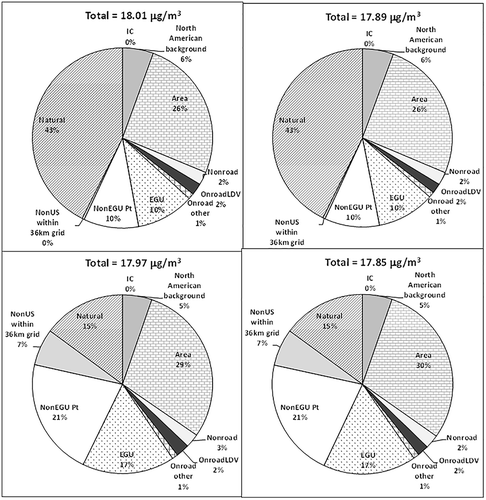
In summary, emissions from gLDVs contribute up to 6.1% to summertime monthly averaged MDA8 O3 in the eastern U.S. following the nationwide implementation of a LEV III program with 10 ppm gasoline sulfur content similar to the Tier 3 standards, decreasing from 9.4% under the previous federal Tier 2 program. The North American background (global background concentrations) could constitute up to a third or more of U.S. ozone. PM precursor emissions from gLDVs in the eastern U.S. contribute up to 6.8% and 3.6% to winter and summer mean PM2.5, respectively, under Tier 3-like standards, decreasing from 9.1% and 4.3%, respectively, under Tier 2, with area source emissions typically contributing over 30% in both programs. At the four urban areas of Atlanta, Detroit, Philadelphia, and St. Louis, gLDV emissions are responsible for up to 5.8% of the mean summertime MDA8 ozone and up to 5.0% of winter/summer mean 24-hr PM2.5 concentrations under the Tier 3 program. When considering only days with higher O3 and PM2.5 concentrations under the Tier 3-like standards, gLDVs contribute up to 6.9% of summertime maximum MDA8 ozone and up to 4.6% to elevated winter/summer 24-hr PM2.5 concentrations across these four areas. Thus, although gLDVs have a slightly (1%) higher contribution to peak O3 compared with the monthly average, their relative contribution to PM2.5 is lower when considering days with higher PM2.5 instead of the monthly average, suggesting that those days are influenced more by other sources.
There is uncertainty in ozone and PM predictions associated with the choice of 2008 as the meteorological year. Weather-adjusted trend analyses of ambient concentrations in the U.S. by EPA (2015) shows that 2008 is neither particularly conducive nor nonconducive to ozone formation in the eastern U.S. The years 2005, 2007, 2010, and 2012 were more conducive to ozone formation in the Northeast than 2008, whereas the years 2003, 2004, 2006, and 2009 were less conducive than 2008 (see – in EPA, 2015). Thus, applying ambient air temperature and other meteorological fields from the former set of years would have likely resulted in greater local anthropogenic contributions (including those from on-road mobile sources) to ozone formation, whereas the converse would be true if meteorology from the latter set of years had been applied in modeling. Similarly, the choice of meteorological year also affects the prediction of the relative contributions of PM, in particular, that of secondary PM from local precursor sources of VOCs and NOx such as on-road LDVs.
The CAMx OSAT and PSAT techniques provide a useful means to explore relative source contributions to ambient ozone and PM2.5 concentrations. The application of these techniques here enables the estimation of the contribution of gasoline-fueled LDVs to residual ambient air pollution in the U.S. in 2030 following the implementation of the Tier 3 emissions and fuel sulfur standards.
Funding
This work was supported by the Coordinating Research Council Atmospheric Impacts Committee under Project A-76-3.
Supplemental Material
Download Zip (1,018.8 KB)Supplemental Material
Supplemental data for this article can be accessed on the publisher’s website.
Additional information
Funding
Notes on contributors
Krish Vijayaraghavan
Krish Vijayaraghavan and Chris Lindhjem are senior managers, Tejas Shah and Bonyoung Koo are managers, Edward Tai and Yesica Alvarez are associates, and Greg Yarwood is a principal at Ramboll Environ US Corporation, Novato, CA, USA. Allison DenBleyker is a staff engineer at Eastern Research Group, Boston, MA, USA.
Chris Lindhjem
Krish Vijayaraghavan and Chris Lindhjem are senior managers, Tejas Shah and Bonyoung Koo are managers, Edward Tai and Yesica Alvarez are associates, and Greg Yarwood is a principal at Ramboll Environ US Corporation, Novato, CA, USA. Allison DenBleyker is a staff engineer at Eastern Research Group, Boston, MA, USA.
Bonyoung Koo
Krish Vijayaraghavan and Chris Lindhjem are senior managers, Tejas Shah and Bonyoung Koo are managers, Edward Tai and Yesica Alvarez are associates, and Greg Yarwood is a principal at Ramboll Environ US Corporation, Novato, CA, USA. Allison DenBleyker is a staff engineer at Eastern Research Group, Boston, MA, USA.
Allison DenBleyker
Krish Vijayaraghavan and Chris Lindhjem are senior managers, Tejas Shah and Bonyoung Koo are managers, Edward Tai and Yesica Alvarez are associates, and Greg Yarwood is a principal at Ramboll Environ US Corporation, Novato, CA, USA. Allison DenBleyker is a staff engineer at Eastern Research Group, Boston, MA, USA.
Edward Tai
Krish Vijayaraghavan and Chris Lindhjem are senior managers, Tejas Shah and Bonyoung Koo are managers, Edward Tai and Yesica Alvarez are associates, and Greg Yarwood is a principal at Ramboll Environ US Corporation, Novato, CA, USA. Allison DenBleyker is a staff engineer at Eastern Research Group, Boston, MA, USA.
Tejas Shah
Krish Vijayaraghavan and Chris Lindhjem are senior managers, Tejas Shah and Bonyoung Koo are managers, Edward Tai and Yesica Alvarez are associates, and Greg Yarwood is a principal at Ramboll Environ US Corporation, Novato, CA, USA. Allison DenBleyker is a staff engineer at Eastern Research Group, Boston, MA, USA.
Yesica Alvarez
Krish Vijayaraghavan and Chris Lindhjem are senior managers, Tejas Shah and Bonyoung Koo are managers, Edward Tai and Yesica Alvarez are associates, and Greg Yarwood is a principal at Ramboll Environ US Corporation, Novato, CA, USA. Allison DenBleyker is a staff engineer at Eastern Research Group, Boston, MA, USA.
Greg Yarwood
Krish Vijayaraghavan and Chris Lindhjem are senior managers, Tejas Shah and Bonyoung Koo are managers, Edward Tai and Yesica Alvarez are associates, and Greg Yarwood is a principal at Ramboll Environ US Corporation, Novato, CA, USA. Allison DenBleyker is a staff engineer at Eastern Research Group, Boston, MA, USA.
References
- Baek, B.H., and A. DenBleyker. 2010. User’s Guide for the SMOKE-MOVES Integration Tool. Prepared for the U.S. Environmental Protection Agency Office of Air Quality Planning and Standards. July. http://cmascenter.org/smoke/documentation/smoke_moves_tool/SMOKE-MOVES_Tool_Users_Guide.pdf (accessed April 2013).
- Boylan, J.W., and A.G. Russell. 2006. PM and light extinction model performance metrics, goals, and criteria for three-dimensional air quality models. Atmos. Environ. 40:4946–4959. doi:10.1016/j.atmosenv.2005.09.087
- California Air Resources Board. 2011. LEV 3 Inventory Database Tool version 9h. November. http://www.arb.ca.gov/msprog/clean_cars/clean_cars_ab1085/lev3-inv-dbase_v9h.accdb (accessed April 2013).
- California Air Resources Board. 2012. Predictive model spreadsheets containing 2011 amendments. http://www.arb.ca.gov/fuels/gasoline/premodel/premodel.htm# (accessed January 2013).
- Collet, S., H. Minoura, T. Kidokoro, Y. Sonoda, Y. Kinugasa, and P. Karamchandani. 2014a. Evaluation of light-duty vehicle mobile source regulations on ozone concentration trends in 2018 and 2030 in the western and eastern United States. J Air Waste Manage. Assoc. 64:175–183. doi:10.1080/10962247.2013.845621
- Collet, S., H. Minoura, T. Kidokoro, Y. Sonoda, Y. Kinugasa, P. Karamchandani, J. Johnson, T. Shah, J. Jung, and A. DenBleyker. 2014b. Future year ozone source attribution modeling studies for the eastern and western United States. J Air Waste Manage. Assoc. 64:1174–1185. doi:10.1080/10962247.2014.936629
- Dunker A.M., G. Yarwood, J.P. Ortmann, and G.M. Wilson. 2002. Comparison of source apportionment and source sensitivity of ozone in a three dimensional air quality model. Environ. Sci. Technol. 36:29532964. doi:10.1021/es011418f
- Emmons, L.K., S. Walters, P.G. Hess, J.-F. Lamarque, G.G. Pfister, D. Fillmore, C. Granier, A. Guenther, D. Kinnison, T. Laepple, et al. 2010. Description and evaluation of the Model for Ozone and Related chemical Tracers, version 4 (MOZART-4). Geosci. Model Dev. 3:43–67. doi:10.5194/gmd-3-43-2010
- ENVIRON. 2011. User’s Guide, Comprehensive Air Quality Model with Extensions (CAMx), Version 5.40. http://www.camx.com (accessed August 2013).
- IMPROVE. 1995. IMPROVE Data Guide. University of California Davis, August 1995. http://vista.cira.colostate.edu/improve/Publications/OtherDocs/IMPROVEDataGuide/IMPROVEDataGuide.htm (accessed August 2013).
- U.S. Environmental Protection Agency. 2010a. Regulatory Impact Analysis for the Proposed Transport Rule. Docket ID No. EPA-HQ-OAR-2009-0491. Washington, DC: Office of Air Quality and Planning Standards, U.S. Environmental Protection Agency. July. http://www.epa.gov/ttn/ecas/regdata/RIAs/proposaltrria_final.pdf (accessed May 2013).
- U.S. Environmental Protection Agency. 2010b. Technical Guidance on the Use of MOVES2010 for Emission Inventory Preparation in State Implementation Plans and Transportation Conformity. EPA-420-B-10-023. Washington, DC: Office of Transportation and Air Quality, U.S. Environmental Protection Agency. April. http://www.epa.gov/otaq/models/moves/420b10023.pdf (accessed June 2013).
- U.S. Environmental Protection Agency. 2010c. Quantitative Health Risk Assessment for Particulate Matter. EPA-452/R-10-005. Washington, DC: Office of Air Quality Planning and Standards, U.S. Environmental Protection Agency. June. http://www.epa.gov/ttn/naaqs/standards/pm/data/PM_RA_FINAL_June_2010.pdf (accessed June 2013).
- U.S. Environmental Protection Agency. 2010d. LEV and Early NLEV modeling information. August. http://www.epa.gov/otaq/models/moves/MOVES2010a/levandearlynlevmodelinginformation.zip (accessed June 2013).
- U.S. Environmental Protection Agency. 2010e. 2020 Emissions Data from EPA’s 2005-Based v4 Modeling Platform. Prepared by Rich Mason, Office of Air Quality Planning and Standards, U.S. Environmental Protection Agency. April 15. ftp://ftp.epa.gov/EmisInventory/2005v4/2020emis/readme_2020_2005v4cap_bafm.doc (accessed July 2013).
- U.S. Environmental Protection Agency. 2011a. CASTNET. Clean Air Status and Trends Network. http://epa.gov/castnet/ (accessed July 2013).
- U.S. Environmental Protection Agency. 2011b. SPECIATE 4.3: Addendum to SPECIATE 4.2. Speciation Database Development Documentation. EPA/600/R-11/121. Prepared for the Office of Research and Development, U.S. Environmental Protection Agency. Prepared by TransSystems, E.H. Pechan & Associates. September. http://www.epa.gov/ttn/chief/software/speciate/speciate4/addendum4.2.pdf (accessed July 2013).
- U.S. Environmental Protection Agency. 2011c. Heavy-Duty Vehicle Greenhouse Gas (HDGHG) Emissions Inventory for Air Quality Modeling Technical Support Document. EPA-420-R-11-008. Washington, DC: Office of Air and Radiation, U.S. Environmental Protection Agency. August. http://www.epa.gov/otaq/climate/documents/420r11008.pdf (accessed July 2013).
- U.S. Environmental Protection Agency. 2013. Air Quality System User’s Guide Version 1.0.0. U.S. Environmental Protection Agency, Technology Transfer Network. July 31. http://www.epa.gov/ttn/airs/airsaqs/manuals/docs/users_guide.html (accessed November 2013).
- U.S. Environmental Protection Agency. 2014a. Control of Air Pollution from Motor Vehicles: Tier 3 Motor Vehicle Emission and Fuel Standards. Final Rule. Research Triangle Park, NC: U.S. Environmental Protection Agency. April. http://www.gpo.gov/fdsys/pkg/FR-2014-04-28/pdf/2014-06954.pdf (accessed April 2014).
- U.S. Environmental Protection Agency. 2014b. Control of Air Pollution from Motor Vehicles: Tier 3 Motor Vehicle Emission and Fuel Standards Final Rule. Regulatory Impacts Analysis. EPA-420-R-14-005. Washington, DC: U.S. Environmental Protection Agency. February. http://www.epa.gov/otaq/documents/Tier 3/420r14005.pdf (accessed March 2014).
- U.S. Environmental Protection Agency. 2015. Air Quality Modeling Technical Support Document for the 2008 Ozone NAAQS Transport Assessment. Office of Air Quality Planning and Standards, U.S. Environmental Protection Agency. January. http://www.epa.gov/airtransport/O3TransportAQModelingTSD.pdf (accessed August 2015).
- Vijayaraghavan, K., C. Lindhjem, A. DenBleyker, U. Nopmongcol, J. Grant, E. Tai, and G. Yarwood. 2012. Effects of light duty gasoline vehicle emission standards in the United States on O3 and particulate matter. Atmos. Environ. 60:109–120. doi:10.1016/j.atmosenv.2012.05.049
- Yarwood, G., R.E. Morris, M.A. Yocke, H. Hogo, and T. Chico. 1996. Development of a methodology for source apportionment of ozone concentration estimates from a photochemical grid model. Presented at the 89th Air & Waste Management Association Annual Meeting, Nashville, TN, June 23–28.

